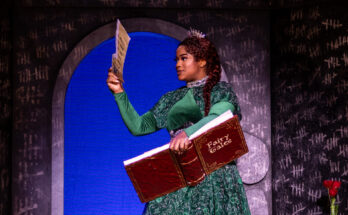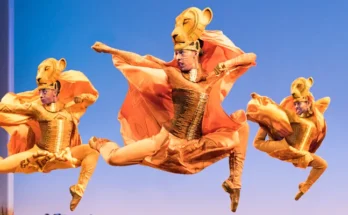By Kristi Casey Sanders
Where were you the first time you saw West Side Story? Christopher B. Manos, Theater of the Stars [TOTS] producer, was on a date with his wife, dancer Glenn Ryman, in 1957.
They took their seats in New York’s Winter Garden Theatre, leaning forward to hear the actors’ voices over the orchestra, and were blown away. “I was astounded to see true ballet movement and people dancing translating into a story,” Manos remembers. “It was a revelation. [Leonard Bernstein’s] music was exciting – I never heard so much brass in my life – it did what rock ’n’ roll did, to musical theater. The style of dancing was created by Jerome Robbins, who was the greatest choreographer (next to Balanchine) in the world. You couldn’t leave the theater without singing [“Tonight”]. I think we hopped, skipped and scotched down the sidewalk.”
The Manos’ were not alone in feeling as if they had witnessed the birth of something new. New York Daily News critic John Chapman called West Side Story a “super-modern musical drama,” noting in his review:
“This is a bold new kind of musical theatre – a jukebox Manhattan opera. It is, to me extraordinarily exciting. … The manner of telling the story is a provocative and artful blend of music, dance and plot. … In [the score], there is the drive, the bounce, the restlessness and the sweetness of our town. It takes up the American musical idiom where it was left when George Gershwin died.”
A half-century after its premiere, West Side Story is considered a classic. But the groundbreaking show took eight long years to come together, and almost never saw the light of day.
The story is a simple one, based on William Shakespeare’s Romeo and Juliet . Two star-crossed lovers from feuding families fall in love, violence ensues and the couple ultimately is united in death (an ending that was altered slightly after audiences complained it was “too depressing”). Playwright Arthur Laurents and Robbins began work on the project in 1949, transforming feuding families into street gangs and moving the action from Italy to New York’s Upper East Side. The original gangs were Roman Catholic (the Jets) and Jewish (the Emeralds). But after Laurents read articles on New York’s surging Puerto Rican population, he changed the lead characters’ nationalities to Polish-American (Tony) and Puerto Rican (Maria), moving the action to New York’s Hell’s Kitchen. Laurents and Robbins engaged 27-year-old Stephen Sondheim to write the lyrics and Bernstein to compose the score. Two months before rehearsals were scheduled to begin in 1957, the original producer dropped out, prompting a scramble to find another backer (Bernstein’s friend Hal Prince and his partner Robert Griffith eventually signed on).
In a 1990 Rolling Stone interview, composer Bernstein reflected on the show’s difficult birth:
“Everyone told us that it was an impossible project. … No one, we were told, was going to be able to sing augmented fourths, as with “Ma-ri-a.” … And then we had the really tough problem of casting it, because the characters had to be able not only to sing, but dance and act, and be taken for teenagers.”
Robbins insisted on an eight-week rehearsal schedule – twice as long as usual – to whip his young cast into shape and prepare them for the rigors of the show, which featured more dancing than any previous Broadway musical. To create tension between the play’s two gangs, the Puerto Rican Sharks and the “American” Jets, Robbins kept the two groups of actors from mingling socially. Robbins also posted news stories about gang violence on the rehearsal hall’s bulletin board, constantly reminding his actors of how relevant West Side Story was. The actors performed in “street clothes” (jeans and sneakers) rather than costumes, which injected a note of gritty realism into the production.
Fifty years after its premiere, West Side Story still packs a powerful punch. “It’s a story of pure ethnic differences overcome by love,” Manos says. “And that’s powerful stuff for America.”
Directing and choreographing the TOTS production is Alan Johnson, a man Manos calls the “heir apparent from the Jerome Robbins estate.” For more than 30 years, Johnson has restaged Robbins’ choreography in productions of West Side Story all over the world. “We attempt to replicate the original dance choreography and original intent,” Manos says.
When asked what his favorite numbers are, Manos replies, “I love the ‘Mambo;’ ‘America;’ the gym scene; the scene about ‘somewhere, there’s a place for us,’ where they dance out what just happened to them; ‘Cool’ is great; I love ‘Officer Krupke’ …
“I guess just about everything,” he laughs. “If I had the ability to change West Side Story , I doubt I would change anything.”
West Side Story plays The Fabulous Fox Theatre Aug. 21-26.



